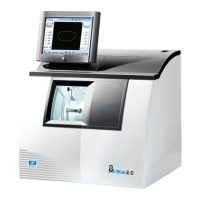
Do you have a question about the Essilor Mr Blue 2.0 and is the answer not in the manual?
| Beveling | Yes |
|---|---|
| Grooving | Yes |
| Drilling | Yes |
| Safety Bevel | Yes |
| Polishing | Yes |
| Maximum Lens Size | 80 mm |
| Maximum Center Thickness | 10 mm |
| Bevel Position Adjustment | Yes |
| Bevel Width Adjustment | Yes |
| Bevel Height Adjustment | Yes |
| Water Cooling System | Yes |
| Lens Material Compatibility | Compatible with all lens materials |
| Dimensions | 630 mm (W) x 531 mm (D) x 478 mm (H) |
| Weight | 68 kg |
| Power | 230 V / 50 Hz |
| Connectivity | USB |
| User Interface | Touchscreen |
| Power Supply | 230 V / 50 Hz |
Overview of the tracer-centerer-blocker's physical components and labels.
Basic operations including powering on/off, screen interaction, and tracing interface.
Description of the tracing screen, menu, and job management interface.
Procedures for managing and storing traced lens shapes.
Methods for tracing rimmed, high-base frames, and patterns/demo/recut lenses.
Using optical tracing for patterns, demo lenses, or recut lenses.
Using mechanical tracing for patterns, demo lenses, or recut lenses.
Entering lens curve and frame base data after monocular tracing.
Overview of the centering screen and available centering modes.
Methods for centering single vision lenses (auto, focimeter, manual, lens fit).
Procedures for centering progressive lenses using various marking systems.
Steps for centering bifocal and trifocal lenses with different methods.
Techniques for centering executive lenses using various modes.
Methods for centering mid-distance lenses with different marking systems.
Specific procedures for centering lenses in high-base frames.
Accessing and managing lens markings in the database.
Step-by-step guide to blocking lenses using the device.
Accessing the shape modification screen and understanding its elements.
Tools for enlarging, reducing, rotating, free-form editing, and retouching shapes.
Procedures for saving modified lens shapes into new jobs.
Explanation of symbols and elements on the drilling screen.
Steps for creating, deleting, dimensioning, and positioning drilling points.
Importing and saving reusable drilling point configurations.
Accessing the screen for preparing lens edging parameters.
Inputting lens material, cycle type, and finish settings for edging.
Setting time, date, language, connections, and screensaver options.
Adjusting working modes, display, decentration, and action bar settings.
Resetting the device to its original factory configuration.
Running self-diagnostic tests for the tracer's functions.
Procedures for checking and calibrating the tracing table and centerer-blocker.
Backing up and restoring jobs and display configurations.
Enabling remote access for technical support and maintenance.
Viewing operational statistics, tracer cycles, and error logs.
Guidelines for cleaning the device and replacing consumables.
Using the engraving function for lens customization.
Utilizing creative distortion for custom lens shape creation.
Detailed technical specifications of the device.
Recommended operating and storage conditions for the machine.
Explanation of symbols used in the digital system and document.
Details on modifications, conformity, copyright, and materials.
Critical safety precautions for operating and maintaining the equipment.
Terms and conditions for using the M'Eye Sign engraving software.